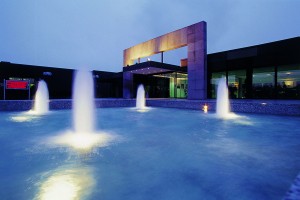It all started with an ambitious goal:
Wincor Nixdorf wants to introduce agile working methods in all teams of the software development department, which has over 300 employees, within a few months. Initial experience with Scrum had already been gained by both the teams and the management. Now, the benefits of the agile approach that had been identified in these teams were to be exploited like a treasure for the entire organization.
At the project and team level, employees are further professionalized in agile techniques and methods so that the positive effects of transparency, short delivery cycles and an iterative approach can actually occur in all teams. At the program level, this involves the coordination of several sub-projects and release planning. For Wincor, the necessary meetings were designed and defined to ensure coordination across the teams. The third level is the transition planning level. It deals with the selection, adaptation and maintenance of an overall model for the new agile Wincor organization. A team of internal and external employees is responsible for orchestrating the project, i.e. managing the measures at thethree levels described.
Project marketing pulls and pushes
The sponsor opted for intensive project marketing early on in order to raise awareness of the project and appeal to emotions. The core team chose "GO Agile" as the project name. The bold and ambitious claim underlines the project vision agreed with the stakeholders: "We evolve our software in a rapid beat. You will love it." When asked, the answer to the most important project objective is correspondingly charged: "We want to get back to "fun & passion" in software development."
Transition - very practical
All teams are supported by agile coaches during the transition to agile working. This means that after initial training in Scrum basics, the team prepares and practices its own work in an agile manner. The coach supports the Scrum Master in finding their way into their role. Over the course of a few sprints, responsibility is transferred entirely to the Scrum Master and the coach withdraws. At the same time, the rituals and meetings for coordination are defined and practised at the program level. The overall model is derived from SAFe, described and trained.
A cookbook for agility
As the central document for the way in which agility is to be implemented at Wincor, everyone is working together on an "Agile Collaboration Framework" - which is affectionately and ironically referred to internally as the "Cookbook". The cookbook records what has been agreed and what has proven successful. It is kept as concise as possible, as it is intended to support and synchronize rather than replace independent thinking. For example, it contains the "big picture", i.e. the overall context of roles, meetings and rituals in software development at Wincor. It shows how requirements are derived from strategic initiatives and into which backlogs they are inserted. But the cookbook also contains definitions and descriptions of meetings. For example, the agreement of a Definition of Ready and Definition of Done in the teams has made a significant contribution to steering the classic conflict between product management and the development department into constructive channels.
Focus groups work on overarching key topics
"A key milestone for the desired
new way of working was reached when we regulated the interface between development and QA. The focus group created a collaborative approach that we hadn't seen before," says Andreas Wübbeke. In addition to this focus group, two others dealt with cross-team topics. The interface topics between Product Line and Development were dealt with in one group and topics that affect several development teams. The focus groups are intended for the duration of the transition or until they have solved the underlying problem. They will therefore not be permanent.
Specific agile model for Wincor
In a project of this size, learning takes place on many levels - if you want it to. Wincor wanted to: "It was an eye-opener for me to manage the transition project as an agile project myself," says Schlögel. Firstly, it shows that many people wrongly limit agility to software development. It also increases credibility in the organization if those who change the existing processes also subject themselves to the changes.
"With agility, we have above all built the learning loops
(inspect & adapt) into the project," continues the development
manager, "which have enabled us to adapt the SAFe model used as a
reference in the way that is necessary for Wincor." As a result, Wincor now has its own agile model that is supported by its own people.
Next steps
Despite all the progress made, there is still no end in sight to agilization at Wincor. On the agenda are the search for and implementation of a suitable tool for developing, processing and documenting requirements from the strategic level to the program level to the projects. Improvements in reporting and the tracking of certain key business figures are also being considered. And finally, there is hardware development at Wincor for which the benefits of agility are also interesting. "We certainly won't be bored in the next few years," says Schlögel. We wish you continued success on the agile path!
This text is taken from the wibas customer magazine.


Write a comment